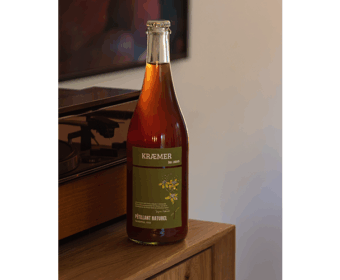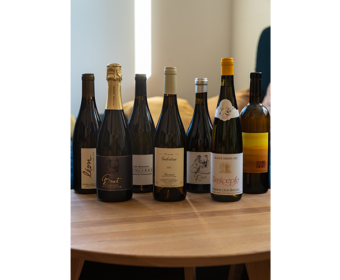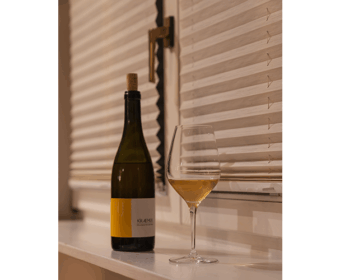A Wild Orange Wine Tasting

For this wine regular’s table, I chose different orange wines. To be fair, there only eight were orange wines and the first one was a Pet Nat. Yet, it was very interesting to see the different effects skin contact can have on white wines.


Iknow that sparkling wines and phenols do not go together. However, I chose the Fred Loimer Pet Nat 2023 as an aperitif for the tasting. For this sparkling wine, 20 % of the grapes (75 % Donauriesling and 25 % Muscat) are destemmed and mash fermented. I thought this would be a great aperitif before all that orange wine. Loimer ferments all the Pet Nat components naturally, and the fermentation ends after six months in the bottle. Afterwards, they disgorge the Pet Nat.
Sparkling Aperitif

My plan worked, even though that everyone noticed that this is not an orange wine. Yet, the fresh green apple and citrus notes along with the great carbonation served as a great refresher. I noticed the slightest hint of phenols, but the Pet Nat stayed very balanced. Through the disgorging the yeast flavour is very well incorporated and the wine is basically clear.

It was difficult to know where to place the Ziereisen Unterirdisch in this tasting. On the one hand, it only clocks in at an ABV of 9,5 %, but Hanspeter really pulls out all the stops when it comes to this orange wine. First, the 100 % red Gutedel grapes ferment intracellulary in amphorae buried in the vineyards for a whole year. Second, the wine spends two years in used barrique barrels. In the end, the wine is bottled with some yeast from the barrels and neither filtered nor fined.
Light, but wild

On the one hand, the second slot in this tasting was the right choice for the red Gutedel. The wine felt lighter, but without losing complexity. On the other hand, this was like throwing someone in at the deep end. The Unterirdisch is very cloudy, mineral with “natural” notes of everything revolving around apples. Yet, if you are up for it this one is a great showcase for orange wines.

For the next one, we continue with the “wild” theme: Phillip from Weinhalle and Westbar recommended Richard Stavek’s Riesling. The grapes, which come from over 40-year-old vines, spend around ten days as whole grapes fermenting. Next, the grapes are pressed by food and the must spends 12 months on the yeast in used acacia wood casks. Richard regularly stirs the yeast and bottles the wine without filtration, fining or the addition of sulphur.
Even wilder

It is fair to say that I never tasted a wine like the RR. Moreover, this also is nothing like any Riesling I have tried so far. The colour alone reminds me more of a vermouth and the flavour does the rest. You can taste wild honey, flowers and bitter herbs. This one polarized quite a bit, but everyone recognized that this would go extremely well with a proper food-pairing.

The Heinrich vineyard in Gols holds a special place in my heart, because it is the first one I remember visiting with my parents as a child. So, I had to include their Graue Freyheit. The wine is a Cuvée of 60 % Pinot Gris from the Joiser Hackelsberg and Windener Spiegel. The remainder comes from the Breitenbrunner Edelgraben and Windener Alter Berg vineyards with 30 % Pinot Blanc, 2 % Chardonnay as well as 8 % Neuburger. Gernot Heinrich leaves the grapes on their skins for 15 days and presses them using a basket press. Next, the wine ages for 17 months in amphorae and used oak barrels on the lees. Ultimately, the wine is not filtered and bottled without the addition of sulphur.
Bright red, instead of orange

This one had the most intriguing colour of all the wines. Obviously, you could expect this from a Pinot Gris orange wine with its red pigments in the skins. After opening, the wine introduced itself with a lot of Burgundy fruitiness. However, after a few hours of air, the flavour changed to a lot of mineral notes reminding me of flint. The acidity is well balanced by the Graue Freyheit’s creaminess and yeast notes.

Next, we covered the topic of solera-aged wine. Vincent Eymann began this project using his Gewuerztraminer from the Goenheimer Mandelgarten in 2014. For his #7 the latest vintage of the Solera comes from 2020. The grapes are harvested by hand, mash fermented for six weeks in stainless steel as well as oak casks. The wine then rests on the lees until bottling without filtration. There are just 600 bottles of this edition.
Almost a crowd pleaser

After all that craziness, the Gewuerztraminer MDG almost came across as soft. Yet, after a short while everyone appreciated the well balanced and complex notes. I especially liked the spiciness with only just the slightest touch of rose petals from the grape variety. Towards the aftertaste some bee’s wax became noticeable. All in all, this was the second highest rated wine in the tasting.

Stephan Kraemer prefers the term ‘white wine with phenols’ to describe his wines. If you take the time to understand what he does, you will see what this means. Yet, things are different with Stephan’s Skin Contact Silvaner. This wine uses only mash and intercellular fermented grapes. The main part comes from a section that was openly mash-fermented in 2018, and 15 % to 20 % come from a Maceration Carbonique that Stephan did in 2020. The wine stays in oak barrels until blending of both parts. As per usual with Kraemer wines, the Skin Contact is neither filtered nor fined with only a minimal addition of sulphur.
Second to last evolution

I get that Stephan has already evolved again from this style. Yet, every wine I tried from that era just blew me away. This also is true for this bottle. The phenols from the skin contact a very well-integrated. Apart from that, you can find complex herbal notes in combination with bee’s wax as well as a certain minerality. Yes, there are yellow fruits in the aroma and taste, but they are far from a simplistic primary Silvaner fruit. In the end, this was the highest rated wine in the whole tasting.

So far, the Selvadolce Pigato Rucantú was the best orange wine I had tasted. This is why, I had to include it in the tasting. The Pigato vines, an old autochthon variety from Liguria, were planted in 1970. After a few days of skin contact, the grapes are pressed and aged in oak casks for two years on the lees. In the end, Aris Blancardi bottles his Rucantú without filtration and fining and only adds a minimal amount of sulphur.
Good, but different

The wine we tried was the 2021 vintage and the wine was dominated by a lot of reductive flavours. I found a lot of flint and matchsticks which only were accompanied by some fruitiness in the taste. This way the phenols were also more pronounced than I had remembered. All in all, the wine was good, but I enjoyed the 2020 vintage a bit more. Nevertheless, this is a great orange wine.

For his Kamen wine, Benjamin Zidarich uses Vitovska grapes, an ancient variety grown on terraces. The wine spends two weeks in natural stone tanks which he had made from karst in his own cellar. After gentle pressing, the wine rests for two years in large oak casks. Like all the wines in this tasting, the Kamen is neither filtered nor fined, and only a very small amount of sulphur is added.
A little bit of age

It was interesting to see what a few years of bottle ageing do to a wine. Even though the Kamen was bone-dry, it had the illusion of sweetness. Apart from that, I found quite some dried fruit notes along with some chalky minerals. All in all, it almost reminded me of a very strict and chalky Chardonnay.

Last, but not least we tried a Georgian orange wine. Afterall, this is where this wine style and arguably wine in general comes from. George Wolski ferments the Krakhuna grapes in a traditional Qvevri with 10 % skins and two weeks of skin contact. He stirs the mash every three hours during this time. Afterwards, the wine spends at least one year in a hermetically sealed Qvevri. As this is a 100 % natural wine, it is neither filtered nor fined and no sulphur is added.
Not for the faint hearted

I know that this is as traditional as it gets when it comes to orange wine. Yet, this one was a bit too much for me. Do not get me wrong, there were no off-notes in this wine, but the intense sulphur flavour was just not something I see myself looking for in a wine. Maybe, I also made the error of not choosing a beginner style Georgian wine.




